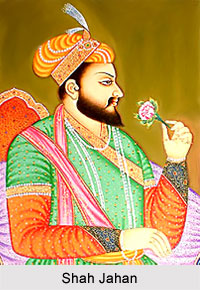 Shah Jahan was a Mughal Emperor who ruled the empire from 1628 to 1658. The son of the Emperor Jahangir and his Rajput Queen, he was born January 5, 1592. Following the death of his father, he proclaimed himself emperor of the Mughal dynasty. He extended the political supremacy which was established in India by Akbar. The empire enjoyed peace and prosperity during his reign. His reign was said to be the golden age of Mughal architecture, and Shah Jahan is most remembered for the construction of the world-famous monument famous Taj Mahal.
Shah Jahan was a Mughal Emperor who ruled the empire from 1628 to 1658. The son of the Emperor Jahangir and his Rajput Queen, he was born January 5, 1592. Following the death of his father, he proclaimed himself emperor of the Mughal dynasty. He extended the political supremacy which was established in India by Akbar. The empire enjoyed peace and prosperity during his reign. His reign was said to be the golden age of Mughal architecture, and Shah Jahan is most remembered for the construction of the world-famous monument famous Taj Mahal.
Reign of Shah Jahan
The reign of Shah Jahan was marked as the golden age of the Mughal dynasty. Shah Jahan was well-educated and cultured, and his is known to have provided protection to scholars. Persian and Sanskrit literature flourished during his reign. He also patronised fine arts like music, painting and architecture. He had several wives, yet he was devoted to them. His love for Mumtaz Mahal has become almost legendary. He loved his children and gave them all necessary training and comforts. He was a hard fighter and a capable commander. He participated in all important campaigns during the life-time of his father and planned all military campaigns himself when he became the emperor. He extended the boundary of the Mughal Empire. While Ahmednagar was completely annexed to the Mughal Empire, Bijapur and Golconda were forced to accept the suzerainty of the emperor. He even attempted to conquer Central Asia and recover Qandahar.
Shah Jahan was a just ruler and earnestly desired the welfare of his subjects. Trade, industry and agriculture flourished and the state as well as the subjects enjoyed prosperity during his reign. He worked hard and personally supervised the administration of the empire. He brought about improvement in the Mansabdari System. He helped his subjects generously in times of famines and natural calamities. With regard to religious affairs, he was certainly orthodox when compared with Jahangir and Akbar, yet he did not interfere in the daily lives of the Hindus and the Christians. He participated in fairs and festivals of the Hindus and continued the practices of Jharokha Darshan and Tula Dan as before. He continued the policy of his father and grand father in his relations with the Rajputs and commanded their loyalty. The regime of Shah Jahan was marked by the birth of trade and commerce in Delhi, Agra, Lahore, and Ahmedabad through an improved network of roads and waterways.
 The greatest accomplishment of this great connoisseur of art was the architectural structures and monuments created in that period. A major change that was noticed is in the substitution of sandstone as a building material in Akbar`s Red Fort with costly marble as in the Diwan-i-am (hall of public audience) or the black marble pavilion of the Shalimar Gardens in Srinagar. The Jami Masjid, the Moti Masjid, the tomb of Jahangir in Lahore definitely deserves mention. Finally, the architectural masterpiece, embodying Shah Jahan`s eternal romance with his beloved wife Mumtaz Mahal is the exquisite Taj Mahal, situated in Agra.
The greatest accomplishment of this great connoisseur of art was the architectural structures and monuments created in that period. A major change that was noticed is in the substitution of sandstone as a building material in Akbar`s Red Fort with costly marble as in the Diwan-i-am (hall of public audience) or the black marble pavilion of the Shalimar Gardens in Srinagar. The Jami Masjid, the Moti Masjid, the tomb of Jahangir in Lahore definitely deserves mention. Finally, the architectural masterpiece, embodying Shah Jahan`s eternal romance with his beloved wife Mumtaz Mahal is the exquisite Taj Mahal, situated in Agra.
Achievements of Shah Jahan
The Mughals attempted to conquer south India as part of their policy right from the reign of Akbar. Shah Jahan pursued the same policy. Besides, the states of south India provided shelter to the rebels against the Mughals. Shah Jahan desired to conquer these states. Ahmednagar became a part of the Mughal Empire in 1633 A.D. The ruling-family of Golconda was Shia and its rule had refused to acknowledge the suzerainty of the Mughals. Shah Jahan desired to conquer Golconda. He was able to manage this when Abdullah Qutub Shah ascended the throne, and he agreed to the terms and conditions of the Mughals Emperor. In 1636 A.D., Shah Jahan attacked Daulatabad. Bijapur was weak at that time due to rebellious attempts of its nobles. Therefore, Muhammad Adil Shah readily agreed for peace and a treaty was signed between the two parties. The Deccan policy of the Mughals proved fairly successful during the reign of Shah Jahan. The existence of Ahmednagar was wiped away while both Bijapur and Golconda accepted the suzerainty of the emperor. Besides, they were forced to pay the annual tribute from time to time and part of their territories and a few of their forts were occupied by the Mughals. Some minor conquests were also made during the reign of Shah Jahan. The Bhils of Malwa and Gonda, Raja Pratap of Palam and the Raja of Little Tibet accepted the suzerainty of the Mughal Emperor while Assam was forced to establish trade relations with the Mughal Empire after constant fighting between the years 1628-39 A.D.
War of Succession
Chaos and bloodshed related to wars of succession for the throne had become the order of Mughal era. All the four sons of Shah Jahan, Dara Shikoh, Shah Shuja, Aurangzeb and Murad, started fighting among themselves during the last years of Shah Jahan`s rule. Shah Jahan personally chose Dara as the would-be-heir. But the Muslim nobles disliked the popular Dara for his liberal mindset. Ultimately Aurangzeb cleansed all obstructions through coercion and bloodshed. He imprisoned Shah Jahan, and murdered Murad and Dara, while the helpless Shah Shuja ran away from India. Shah Jahan died on January 22 1666, in Agra.



















